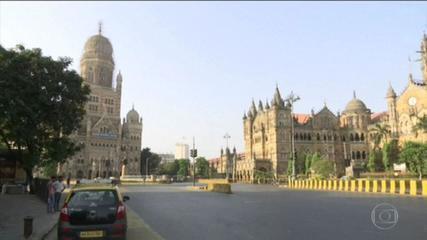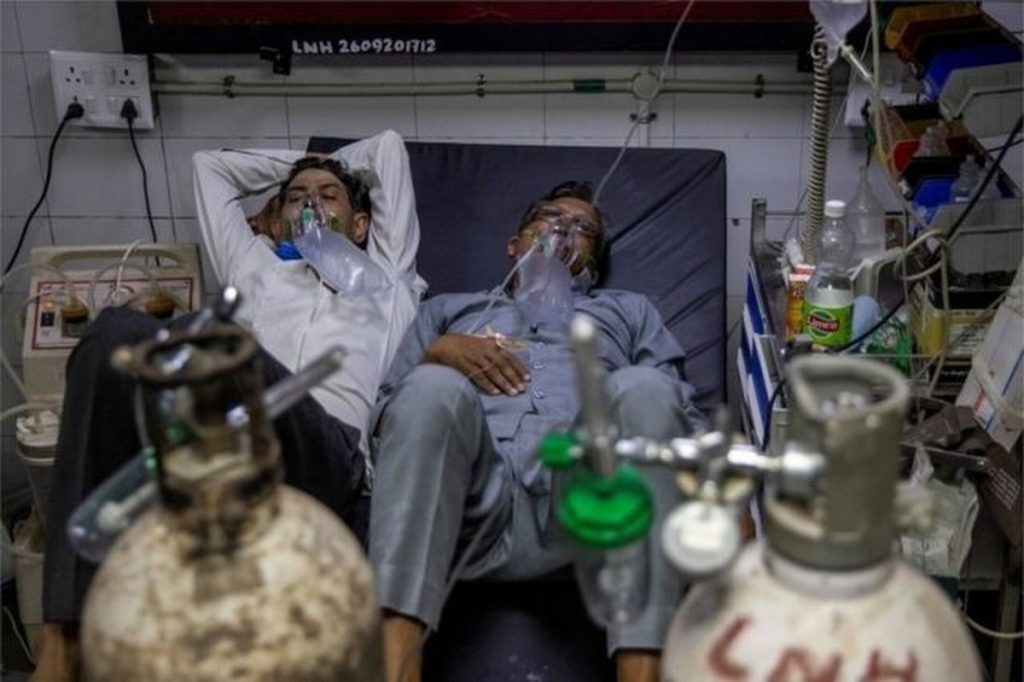In early March, the Minister of Health IndiaHarsh Vardan, announced that the country was in the “final stage” of Covid-19.
Vardan also hailed the leadership of Prime Minister Narendra Modi as “a model for the world in international cooperation.” In January, India began sending doses to foreign countries as part of his often vaunted “vaccine diplomacy”.
Vardan’s unbridled optimism rested on the sharp drop in infection notifications.
Video: Devotees participate in bathing rituals during the pandemic in India
Since a peak of more than 93,000 cases per day, on average, in September, infections have steadily decreased. In mid-February, India had an average of 11,000 cases per day. The seven-day moving average daily death from disease has fallen below 100.
The euphoria to beat the virus has been on the rise since the end of last year. Politicians, lawmakers and a portion of the press believed that India was indeed out of danger.
In December, central bank officials announced that India was ‘Flip the curve of COVID-19’. They said, in poetic terms, there was evidence that the economy was “emerging from the increasingly long shades of winter toward a place in the sun.” Moody has been dubbed “the vaccine expert.”
In late February, Indian electoral authorities announced major elections in five states, in which 186 million people could vote for the seats in the 824 seats. As of March 27, polls will last more than a month and, in the case of West Bengal, will be conducted in eight stages. The campaign started in full swing, with no safety and social distancing protocols in place.
Family members of someone who died of coronavirus while awake – Photo: HINDUSTAN TIMES / GETTY IMAGES
In mid-March, the authorities of cricket, a popular sport in India, allowed more than 130,000 fans. Most of them are without a maskWatch two matches between India and England at Narendra Modi Stadium in Gujarat.
In less than a month, things began to get complicated. India has fallen into the grip of a devastating second wave of the virus and cities face new lockdowns.
In mid-April, the country had an average of over 100,000 new cases per day. On Sunday (18/4), it recorded more than 270,000 cases and more than 1,600 deaths. If nothing is done, India could record more than 2,300 deaths per day in the first week of June, according to a report by the India Task Force for the Lancet covid-19.
Close and prevent the export of the vaccine
India is now facing a public health emergency. The capital, New Delhi, has just slapped Close for a week after a record increase in cases That has burdened the city’s healthcare system.

The Indian capital is in lockdown to try to curb the epidemic
Social media channels are filled with funeral videos of Covid-19 deaths in crowded cemeteries, relatives intending for the dead outside hospitals, long lines of ambulances carrying patients gasping for air, morgue overflowing with the dead, and the sick, sometimes two by bed, in the corridors and halls of hospitals.
There are frantic calls for help with family, medication, oxygen, and tests. Medicines are sold on the black market and test results take days. “For three hours, they didn’t tell me my son was dead,” said a distraught mother in a video, sitting outside the intensive care unit.
even in The massive vaccination effort in India is now suffering. Initially, the campaign was plagued by controversy over the effectiveness of a local vaccine. Now, even as the country speeds up the campaign and delivers more than 100 million doses until last week, vaccines are in short supply.
The Serum Institute in India, the country’s largest vaccine manufacturer – and in the world – said it would not be able to increase supplies before June because it did not have the financial resources to expand its capacity.
Thus, India has temporarily halted all exports of Oxford vaccine with AstraZeneca, as the doses were urgently needed within the country. It also allowed the import of foreign vaccines. It is likely that oxygen will now be imported to meet the increased demand.
Meanwhile, in an almost parallel world, far from death and despair, The world’s richest cricket tournament was played behind closed doors every nightTens of thousands of people followed their leaders at the rallies and others attended the Kumbh Mela Hindu festival. “What is happening goes beyond surrealism,” said Professor of Sociology to Chef Vesvanathan.
Experts believe the government appears to have dropped the shuttlecock completely in relation to the second wave of infections that were about to hit India.
In mid-February, Indian Express journalist Tabassum Barnagarwala pointed out A. Seven times the increase in new cases In parts of Maharashtra, India’s second most populous state. He also reported that to check for the appearance of the variants, samples of the infection were sent for genome sequencing.
At the end of the month, the BBC reported on the increase, questioning whether India was facing a new wave of Covid-19. “We don’t really know the cause of the increase,” said Dr. Shyamsundr Nekam, a civil surgeon in one of the affected provinces in Maharashtra. time.
Experts now say praising India’s achievement in “winning” the epidemic and declaring victory over the virus turned out to be cruelly premature. “As is customary in India, official arrogance, hyper-nationalism, populism and a heavy dose of bureaucratic incompetence combined to create a crisis,” said Mihir Sharma, a columnist for Bloomberg.
What triggered the new Covid wave?
It was fueled by the second wave in India People who let their guard down, attending weddings, social gatherings and mixed government messages, Allowing political gatherings and religious meetings.
As infections decreased, fewer people were getting vaccinations, which slowed down the vaccination campaign, which was aiming to vaccinate 250 million people by the end of July. In mid-February, Pramar Mukherjee, a biostatistician at the University of Michigan, tweeted that India needed to “speed up the vaccination campaign while the number of cases is low”. This opportunity has not been taken.
Srinath Reddy, President of Public Health Corporation of India: “There was a sense of triumph.” He said, “Some felt that we had achieved collective immunity. Everyone wanted to return to work. This story caught many ears, and the few voices of warning were not answered.”
The second wave might have been inevitable, but India could have done. “Was delayed or delayed, and their effects diminished. “Said Gautam Menon, professor of physics and biology. Menon noted, like many other countries, India should have started careful genetic surveillance in January to detect the variants.
Some of these variables may be the drivers of the increase. He added, “We learned of new variants in February from the reports received from Maharashtra state. This was initially denied by the authorities.” “This was an important turning point.”

What We Should Know About PFF2 / N95 Masks
What are the lessons learned from this public health crisis?
On the other hand, India must learn Not to declare victory over the virus prematurely Victory must end.
People must also learn to adapt to short-term, local lockdowns should future, inevitable spikes of infection occur. Most epidemiologists expect more waves, as India is clearly far from achieving herd immunity and the vaccination rate remains low.
“We cannot freeze human life,” said Professor Reddy. “If we can’t physically distance ourselves in densely populated cities, we can at least make sure everyone is wearing an appropriate mask. And in an appropriate manner. There’s not much to ask.”
Videos: COVID-19 vaccination in Brazil

“Music fanatic. Professional problem solver. Reader. Award-winning tv ninja.”






More Stories
Couple retakes glacier photo after 15 years, surprised by changes: ‘It made me cry’
Two killed in hotel collapse in Germany – DW – 07/08/2024
Lula speaks for half an hour on phone with Biden about Venezuela’s electoral impasse | Politics